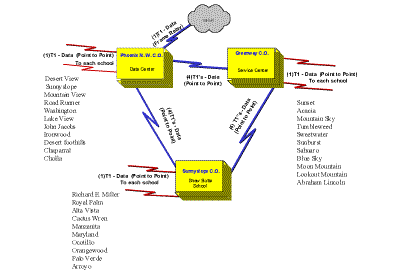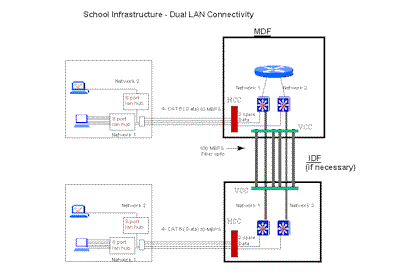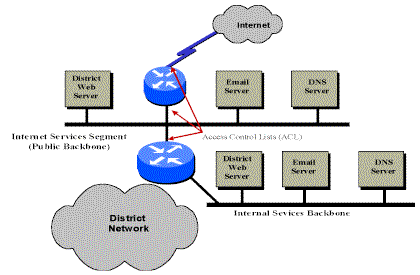Overview of Threaded Case Study (TCS):
(Notes, suggestions and information related to the case study for each semester will be referenced in this section.) The TCS is a performance assessment that will be introduced in the first semester although the actual project work will not be done until semesters 3 and 4. As concepts are introduced, students will learn to apply them. The Engineering Journal and the Study Guide will contain content, concepts, and understandings from the first two semesters that will assist in building the prerequisite knowledge for the TCS. A large school district in Phoenix, Arizona will be the field model that is included in the TCS. Each team of students will be given architectural drawings (electronically) of the various schools along with the actual wiring drawings (electronic format.) The completed design considerations and specifications document will be included as a teacher resource. Each student will keep an Engineering Journal and a Study Guide during the four-semester course. Teams of students will submit a final design document and make an oral presentation of their project near the end of semester 4. Criteria for the project will be a series of rubrics that are linked to National Standards in the areas of Science, Mathematics, Reading, Writing, and SCANS.

Technology Implementation Requirements
General RequirementsThe school district is in the process of implementing a enterprise wide network which will include Local Area Networks (LANs) at each site and a Wide Area Network (WAN) to provide data connnectivity between all school sites. Access to the "Internet" from any site in the school district is also an integral part of this implementation. Once the network is in place the school district will implement a series of servers to facilitate online automation of all of the districts administrative and many of the curricular functions. Since this network implementation will have to continue to be functional for a minimum of 7-10 years all design considerations should include 1000% growth in the LAN's and 100% growth in the WAN. The minimum requirement for initial implementation design will be 1.0 Mega Bits per second to any host computer in the network and 100 Mega Bits per second to any server host in the network. Only two OSI layer 3&4 protocols will be allowd to be implemented in this network, they are TCP/IP and Novel's IPX.
TABLE OF CONTENTS
SECTION 1 - Wide Area Network SECTION 2 - Local Area Network & Wiring Scheme SECTION 3 - District Supplied Servers and Functions SECTION 4 - Address and Network Management SECTION 5 - Security SECTION 6 - Internet ConnectivitySECTION 1 - WIDE AREA NETWORK
The Washington School District Wide Area Network (WAN) will connect all school and administrative offices with the district office for the purpose of delivering data. The WAN will be based on a two layer hierarchical model. Three (3) regional Hubs will be established at the District Office, Service Center and Shaw Butte Elementary School for the purpose of forming a fast WAN core network. School locations will be connect into the WAN core hub locations based on proximity to hub.

TCP/IP and Novel IPX will be the only networking protocols
that will be acceptable to traverse the district WAN. All
other protocols will be filtered at the individual school
sites using Routers. Routers will also be installed at
each WAN core location. Access to the "Internet" or any other
outside network connections will be provided through the
District Office through a frame relay WAN link. For security
purposes, no other connections will be permitted.
SECTION 2 - LOCAL AREA NETWORK & WIRING SCHEME
Two Local Area Networks (LAN) segments will be implemented in each school and the District office. The transport speeds will be Ethernet 10BaseT, 100BaseT and 100baseFx. Horizontal cabling shall be Category 5 Unshielded Twisted Pair (CAT5 UTP) and will have the capacity to accommodate 100 mbps . Vertical (Backbone) cabling shall be CAT5 UTP or fiberoptic multimode cable. The cabling infrastructure shall comply with EIA/TIA 568 standards. One LAN will be designated for student / curriculum usage and the other will be designated for administration usage (see: SECURITY SECTION). The LAN infrastructure will be based on ethernet LAN switching which will allow for a migration to faster speeds (more bandwidth) to the individual computers and between MDF's and IDF's without revamping the physical wiring scheme to accomodate future applications. In each location a Main Distribution Facility (MDF) room will be established as the central point to which all LAN cabling will be terminated and will also be the point of presence for the Wide Area Network connection. All major electronic components for the network, such as the routers and LAN switches will be housed in this location. In some cases an Intermediate Distribution Facility (IDF) room will be established, where horizontal cabling lengths exceed EIA/TIA recommended distances or where site conditions dictate. In such cases, the IDF will service its geographical area and the IDF will be connected directly to the MDF in a STAR or EXTENDED STAR topology. Each room requiring connection to network will be able to support 24 workstations and be supplied with four (4) CAT 5 UTP runs for data, with one run terminated at the teachers workstation. These cable runs will be terminated in the closest MDF or IDF. All CAT 5 UTP cable run will be tested end-to-end for 100 mbps bandwidth capacity. A single location in each room will be designated as the wiring point of presence (POP) for that room. It will consist of a lockable cabinet containing all cable terminations and electronic components; i.e. data hubs. From this location data services will be distributed within the room via decorative wire molding. Network 1 will be allocated for general curriculum usage and network 2 will allocated for administrative usage.

SECTION 3 - DISTRICT SUPPIED SERVERS AND FUNCTIONS
All file servers will be catagoized as Enterprise or Workgroup type services then place on the network topology according to function and anticipated traffic patterns of users.
DOMAIN NAMES SERVICE and EMAIL SERVICES
Domain Name Services (DNS) and E-Mail delivery will be implemented in a hierarchical fashion with all services located on the master server at the district office. Each Hub location will contain a DNS server to support the individual schools serviced out of that location. Each school will also contain a host for DNS and E-mail services (local post office) that will maintain a complete directory of all staff personnel and student population for that location. The school host will be the local post office box and will store all E-mail messages. The update DNS process will flow from the individual school server to the Hub server and to the district server. All regional servers will have the capability to communicate between themselves thus building redundancy in the system in the event that the District master server is unavailable. Should the District master server require a partial or complete restore of data, the ability to query any or all of the regional servers to aquire the needed information will be provided.ADMINISTRATIVE SERVER
The school district is moving towards a totally automated server based administration system.Each school location will contain an Administration server which will house the student tracking, attendance, grading and other administration functions. This server will be running TCP/IP as its OSI layer 3&4 protocols and will only be made avalible to teachers and staff.LIBRARY SERVER
The school district is implementing an automated library information and retrieval system which will house an online library for curricular reseach purposes. This server will be running TCP/IP as its OSI layer 3&4 protocols and will made available to anyone at the school site.APPLICATION SERVER
All computer applications will be housed in a cenrtal server at each school location. As applications such as Word processing, Excel, PowerPoint , etc are requested by users these applications will be retrieved from the application server. This will provide district support staff with a easy and efficient method for upgrading applications without having to reload new software on each computer in the district network. This server will use TCP/IP as its OSI layer 3&4 protocols and will be made available to anyone at the school site.OTHER SERVERS
Any other servers implemented at the school sites will be considered departmental (workgroup) servers and will be placed according to user group access needs. Prior to implementation of other servers a requirements analysis must be submitted for the purpose of determining placement of the server on the district network.SECTION 4 - ADDRESSING AND NETWORK MANAGEMENT
A complete TCP/IP addressing and naming convention scheme for all host, servers and network interconnect devices will be developed and administered by the District Office. The implementation of unauthorized addresses will be prohibited. All computers located on the administrative networks will have static address, curriculum computers will obtain addresses by utilizing Dynamic Host Configuration Protocol (DHCP). A master network management host will be established at the District Office and will have total management rights over all devices in the network. This host will also serve as the router configuration host and maintain the current configurations of all routers in the network. Each region location will house a regional network management host to support its area. The management scheme for the data portion of the network will be based on the Simple Network Management Protocol (SNMP) standards. All routers will be pointed to the master Network Management host for the purpose of downloading new or existing configurations. The District Office will maintain the super user passwords for all network devices and configuration changes on these devices will be authorized from the District Office: i.e. Routers and Lan Switches.
SECTION 5 - SECURITY
External Threats - Internet Connectivity shall utilize a double firewall implementation with all Internet exposed applications residing on a public backbone network. In this implementation all connections initiated from the Internet into the schools private network will be refused. In the district security model the network will be divided into three (3) logical network classifications, Administrative, curriculum and external with secured interconnections between them. This model will dictate that two physical LAN infrastructures
be installed at all schools and the District Office, with one
designated administrative and the other curriculum. Every
computer and file server will be categorized according to its
function and placed on the appropriate LAN segment At the schools
each LAN segment will have a file server. All applications will
be categorized and placed on the appropriate server.
By utilizing Access Control Lists (ACL'S) on the routers, all
traffic from the curriculum LANs will be prohibited on the
administration LAN. Exceptions to this ACL can be made on an
individual basis. Applications such as E-Mail and Directory
services will be allowed to pass freely since they pose no risk.
A user ID and Password Policy will be published and strictly
enforced on all computers attached to the administration LAN.
All computers in the District network will have full access
to the Internet.
All ACLs will be controlled at the district office and
exceptions to the ACLs will be reviewed prior to implementation.
This model will dictate that two physical LAN infrastructures
be installed at all schools and the District Office, with one
designated administrative and the other curriculum. Every
computer and file server will be categorized according to its
function and placed on the appropriate LAN segment At the schools
each LAN segment will have a file server. All applications will
be categorized and placed on the appropriate server.
By utilizing Access Control Lists (ACL'S) on the routers, all
traffic from the curriculum LANs will be prohibited on the
administration LAN. Exceptions to this ACL can be made on an
individual basis. Applications such as E-Mail and Directory
services will be allowed to pass freely since they pose no risk.
A user ID and Password Policy will be published and strictly
enforced on all computers attached to the administration LAN.
All computers in the District network will have full access
to the Internet.
All ACLs will be controlled at the district office and
exceptions to the ACLs will be reviewed prior to implementation.

SECTION 6 - INTERNET CONNECTIVITY
All Internet connectivity will be supplied through the District Office with the District Office being the single point of contact for all schools and organizations within the district. This connection will be highly controlled and capacity (bandwidth) upgraded as usage dictates. e Internet connection will utilize double firewall implementation with a public network (ethernet backbone) established for services that will be exposed to the Internet such as master E-mail, Domain Name Services (DNS) and a World Wide Web server. All connectivity that is initiated from the Internet to the internal District network will be protected via Access Control Lists (ACLs) on the routers that make up the double firewall architecture. Any connectivity initiated from the District to the Internet will be permitted to communicate freely. E-mail and DNS services will communicate freely in both directions since these applications poses no security threat. A Web server will be located on the public backbone and partitioned to allow any school to install a Web home page on the Internet. Individual Web servers that need total exposure to the Internet will not be permitted on the internal istrict network. If schools require an independent web server host, this host will be placed on the public network backbone.